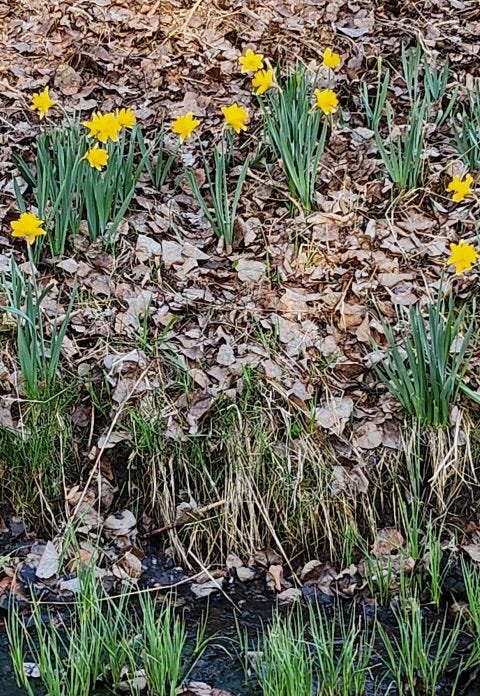1 Week, 7 Stories #62
White House shuts out news agency while promoting free speech, black market in oil taking off while diamonds take a dive.
Every edition features 7 stories from the past week. I’ll draw on my background in media, journalism, agriculture, biotech, and renewable energy to come up with an interesting selection and offer some context.
It is chilly here in Alberta with some extreme cold warnings. Meanwhile Ontario, Quebec, and Atlantic Canada are getting snow, freezing rain, and ice pellets. Let’s turn our back on winter for a moment and look ahead to warmer times and daffodils.
The United Kingdom’s Royal Horticultural Society is mapping the UK’s daffodils and wants to locate three varieties that are at risk or thought to be extinct: “Mrs. R.O. Backhouse”, “Mrs. William Copeland”, and “Sussex Bonfire”.
In the UK and here in Canada, daffodils are fairly simple to grow and hardy, which has helped them become a bit of a favourite here in Alberta. They are generally the first to bloom in most gardens so are also considered a harbinger of spring. Daffodils are in the genus Narcissus and its name comes from an alteration of another flower, the asphodel though no one seems to sure why or how the ‘D’ came to be added.
The endangered R.O. Backhouse variety they are trying to locate and map in the UK is named after Sarah Backhouse who bred and propagated the first true pink daffodil. Overall daffodils are prolific in the UK thanks to the efforts of botanists in the late 1800’s and later when the country turned its attention to food production during the Second World War. Millions of daffodil bulbs were dumped to make room for crops and vegetable gardens and those bulbs sprung up and thrived where they were dumped. Daffodils came to North America after the settlement of the Jamestown colony in Virginia and soon made their way to Canada.
So don’t look outside at the cold and snow. Just kick back and think about spring blooms of a neat little flower found right across Canada where they have earned their place as the flower of hope.
In March of last year the first genetically edited pig kidney was transplanted into a living recipient. He died a couple of months later of an “unexpected cardiac event” and at the time there was no sign of his body rejecting the kidney.
There have been four more xenotransplants since then, but only one patient is still alive. Massachusetts General Hospital has now announced a sixth has taken place and the patient has left the hospital, free from dialysis and living with his new organ.
There are about 100,000 people in the US and 2,500 in Canada on kidney transplant waitlists and every year many die while waiting for a donation match. Many more are on dialysis which increases long term patient risk and health care costs. The idea of using non-human organs is an intriguing solution and earlier this month the US Food and Drug Administration (FDA) gave approval for two companies to conduct clinical trials. The previous transplants took place under the FDA's compassionate use program and the clinical trial will allow more detailed studies to be done. One of the conditions of the trials is a pause between patients to make sure there are no unexpected problems. Initially six transplants will be conducted with the goal of enrolling 50 people.
The kidney used in the latest transplant came from eGenesis, a company co-founded by geneticist George Church using CRISPR technology. There were 69 genomic edits on the donor pig which removed potentially harmful porcine genes, added human genes to improve compatibility, and inactivated viruses to control the risk of infection in the recipient.
Cross species transplants could transform how we handle organ transplants and manage organ donation shortages. It does however have ethical implications and Vox does a good job of outlining the questions raised by the practice.
While the science is being refined and better understood, for many patients it is the only answer.
I see a new TV franchise on the horizon: CSI: Dark Web.
This week TechCrunch reported on the seizure of a dark web site and its content run by the 8base gang. It took agencies from Europe, Japan, the U.S., and the U.K. to crack the case. The gang is known for indiscriminate targeting of small to medium sized businesses across sectors but have gone after healthcare companies and the United Nations Development Programme. The U.S. Health Sector Cybersecurity Coordination Center says that 8Base is a data-extortion cybercrime operation as opposed to many of the ransomware threats we read about more often. Data extortion involves stealing sensitive information and threatening to release it unless they are paid. Those data releases are usually posted across the dark web.
According to VMware Security the group has been active since March of 2022. The business model for 8Base (yes, cybercrime has its own business models!) also involved ransomware-as-a-service where developers sell off-the-shelf ransom or malware code to other hackers. Cyperscoop says that has yielded $16 million worth of Bitcoin from over 1,000 individuals. 8Base has taken the high road in the past claiming it only targeted organizations which “neglected the privacy and importance of the data of their employees and customers”.
The whole operation to take down the organization was a true whodunnit involving tracking networks, unravelling infrastructure, and tracing financial transactions. Codeaintel says it is an important bust but as cybercrime is always evolving, other groups with better or more efficient operations will take their place.
Tuesday was Safer Internet Day so I hope you took the time to brush up on your cybersecurity knowledge!
A medium size oil tanker is a big beast. It can carry up to 300,000 barrels of oil and though their size means they can access most ports around the world, their deadweight is still 25,000 to 50,000 tons and they are 205 metres in (675 feet) long. Not an easy thing to hide or skulk around in, but the black market for oil is thriving according to Bloomberg this week as tankers continue to move the product.
With sanctions in place by the European Union and the United States, Russia needs to find customers for the 10 million barrels of oil it produces every day. The U.S. president has also said he wants to reduce Iran’s crude oil exports to zero and has imposed sanctions to put pressure on shipments to China. In a U.S. Department of the Treasury media release last week specific individuals, tankers, and companies were targeted.
But tankers continue to find and move supplies as the black market grows to a billion dollars a day says the Economic Times.
The Harvard International Review says one means of shipping black market oil is to move it through partner countries to hide the shipment’s origin and then mixing it with a non-sanctioned supply. The Washington Post found that after multiple changes in ownership the U.S. military ended up buying the dodgy mix from a Greek refinery. Another method is for the raw crude to be shipped to willing countries such as India or China where it is legitimately refined and then sold on which breaches the purpose of the sanctions, but not the specific wording.
I have written previously about ‘shadow fleets’ of ships which move illegal or sanctioned goods (mostly oil) and the practice has been growing for several years now. Windward, a maritime risk management company, estimates there were 1,300 dark fleet and an additional thousand gray fleet vessels operating around the world in 2024.
Apart from the political implications of a growing black market in oil, Vox has called many of these vessels “rustbuckets” which could pose an ecological threat as they dodge sanctions, inspections, and regulations. The Atlantic Council (a U.S. nonprofit think tank independent of government) says that the increase in shadow fleet size poses a threat to global maritime order and to the environment.

By the time you read this, Valentine’s Day will be over. I hope you didn’t give someone a diamond as a token of your feelings because it seems the diamond market is in trouble and with it the value of that little bauble you may have purchased.
Bloomberg says this week that an extended slumping market for diamonds has left De Beers “floundering for answers”, and in this video from December also reported that the company was slashing wholesale prices. De Beers is owned by Anglo American which holds 85% and the Government of Botswana which has the remaining 15%, but Anglo American wants to re-structure and sell off De Beers. The company’s chief executive said in early February they want to be free of De Beers by the end of this year.
There seems to be a couple of reasons behind the industry slump, with lab-grown diamonds being the chief cause. Creating a diamond in the lab is difficult because of the need for extreme pressure and temperature. They were first produced in the 1950s, but new technology and increased efficiency have made the production from a tiny piece of real diamond ‘seed’ to start the process to the final product, much more affordable. This process can be customized and controlled, and this has reduced the cost not just for the lab diamonds, but the value of real diamonds takes a subsequent hit as well. The Guardian reports that the price for natural diamonds has fallen to the lowest this century while the market for lab grown diamonds could reach US$37.32 billion by 2028.
Another factor in the lab vs mined diamond market is the industrial and commercial market for the gem. Diamonds are used in cutting and drilling tools, play a role in some electronics because they conduct heat well, are part of high-end audio equipment, and for the rich and famous, diamond dust is used in beauty products. Lab developed diamonds can be customized for size and shape making them considerably less expensive than the work and costs to mine and cut the real thing for users outside the jewelry market.
If you are planning on buying a diamond for an upcoming 60th or 75th anniversary consider waiting as long as you can because when it comes to value, diamonds may not be forever.
Amazing what you can find when out on a training mission.
During a surveying training exercise last June, members of the 673rd Civil Engineer Squadron found an old food cache in a remote, wooded part of the base near Anchorage, Alaska says Stars and Stripes magazine. It took some time for radiocarbon dating to determine exactly how old, but Smithsonian Magazine says it has now been confirmed as being a 1,000 year old find. The discovery is of even more interest because most of the area was razed by the U.S. military when the Joint Base Elmendorf-Richardson was being constructed in the 1940s.
Cache pits such as this one were used to preserve fish, meat, and berries. They were just a little more than a metre deep (3.5 feet) and lined with birch bark and grass. The site sits on a traditional trail used by the Dena’ina and Ahtna people and the cache would have provided needed supplies as people moved along the trail across the seasons.
A tribal historic preservation officer in the area said “I feel like every site that we learn about, every site that we can further investigate, is a piece of our history that was potentially lost. So this is kind of regaining some of the history that we were separated from.”
A wrap this week with a story from the media freedom front.
Associated Press reporters were barred from an official White House event this week because the news agency was not referring to the Gulf of Mexico as the Gulf of America. If you recall on January 20th in #47’s stack of executive orders was one called “Restoring Names that Honor America’s Greatness” which directed that the Gulf of Mexico would become the Gulf of America.
The AP Stylebook is used by journalists and writers around the world, and I have a copy on the shelf behind me and receive digital updates. After the President’s order, AP pointed out in one of those updates that the Gulf of Mexico has carried that name for more than 400 years and the presidential order only has authority in the United States. It went on to say:
“The Associated Press will refer to it by its original name while acknowledging the new name Trump has chosen. As a global news agency that disseminates news around the world, the AP must ensure that place names and geography are easily recognizable to all audiences.”
The president’s reason for the change was that “we do most of the work there and it's ours” and couldn’t resist the additional dig that Mexico had to stop allowing millions of people to “pour into our country”.
That order came onto effect this week which led the White House to bar Associated Press, a not-for-profit agency which has been around since 1846. It has won 59 Pulitzer Prizes and shared an Academy Award with PBS for ‘20 Days in Mariupol’, and has journalists in all 50 U.S. states and across the world in nearly 100 countries. Chances are many of the news stories you read either are AP stories or “use files from AP”.
The U.S. president can change names within his own country, but not beyond. AP acknowledged this and said:
“The Associated Press will use the official name change to Mount McKinley. The area lies solely in the United States and as president, Trump has the authority to change federal geographical names within the country.”
Google is falling into line with the president, and it appears that Apple and Microsoft will be falling into line as well for U.S. users and may or may not change it for non-American users. I checked Google Earth and right now it reads “Gulf of Mexico (Gulf of America)”. Encyclopaedia Britannica is set to take a similar approach to AP.
While there is a United Nations Group of Experts on Geographical Names which offers recommendations on standardizing names it has no binding authority. Similarly, even with an executive order, even the U.S. president does not have binding authority on the media’s use of names or on how other countries refer to the Gulf of Mexico.
Though barring specific reporters or outlets is unusual, it has happened before. Not surprisingly the most recent was during the current president’s first term.
In his January 20th, 2025, inaugural address the president said:
“After years and years of illegal and unconstitutional federal efforts to restrict free expression, I will also sign an executive order to immediately stop all government censorship and bring back free speech to America.
Never again will the immense power of the state be weaponized to persecute political opponents, something I know something about. We will not allow that to happen. It will not happen again. Under my leadership, we will restore fair, equal, and impartial justice under the constitutional rule of law.
Never again! It will not happen again! Stop all government censorship!”
AP may beg to differ on the progress made to date.
Read, comment, subscribe, and share this newsletter.
Next week you will be receiving the next short story from my re-imagining of Chris de Burgh’s album Spanish Train And Other Stories. The first went over well so please check it out.
I’m still available for contract, freelance, and ghost-writing work with not-for-profits and charities. With 40 years of experience behind me and lots of time ahead of me, I’m here to help you make a difference in your media relations, public relations, and general communications needs.



